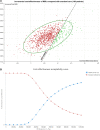Cost-Effectiveness of Mobile Stroke Unit Care in Norway
- PMID: 35862205
- PMCID: PMC9508956
- DOI: 10.1161/STROKEAHA.121.037491
Cost-Effectiveness of Mobile Stroke Unit Care in Norway
Abstract
Background: Acute ischemic stroke treatment in mobile stroke units (MSUs) reduces time-to-treatment and increases thrombolytic rates, but implementation requires substantial investments. We wanted to explore the cost-effectiveness of MSU care incorporating novel efficacy data from the Norwegian MSU study, Treat-NASPP (the Norwegian Acute Stroke Prehospital Project).
Methods: We developed a Markov model linking improvements in time-to-treatment and thrombolytic rates delivered by treatment in an MSU to functional outcomes for the patients in a lifetime perspective. We estimated incremental costs, health benefits, and cost-effectiveness of MSU care as compared with conventional care. In addition, we estimated a minimal MSU utilization level for the intervention to be cost-effective in the publicly funded health care system in Norway.
Results: MSU care was associated with an expected quality-adjusted life-year-gain of 0.065 per patient, compared with standard care. Our analysis suggests that about 260 patients with ischemic stroke need to be treated with MSU annually to result in an incremental cost-effectiveness ratio of about NOK385 000 (US$43 780) per quality-adjusted life-year for MSU compared with standard care. The incremental cost-effectiveness ratio varies between some NOK1 000 000 (US$113 700) per quality-adjusted life-year if an MSU treats 100 patients per year and to about NOK340 000 (US$38 660) per quality-adjusted life-year if 300 patients with acute ischemic stroke are treated.
Conclusions: MSU care in Norwegian settings is potentially cost-effective compared with conventional care, but this depends on a relatively high annual number of treated patients with acute ischemic stroke per vehicle. These results provide important information for MSU implementation in government-funded health care systems.
Keywords: ischemic stroke; repefusion; thrombectomy; time-to-treatment; triage.
Figures


Similar articles
-
Mobile stroke units services in Germany: A cost-effectiveness modeling perspective on catchment zones, operating modes, and staffing.Eur J Neurol. 2025 Jan;32(1):e16514. doi: 10.1111/ene.16514. Epub 2024 Nov 6. Eur J Neurol. 2025. PMID: 39506352 Free PMC article.
-
A Prospective Multicenter Analysis of Mobile Stroke Unit Cost-Effectiveness.Ann Neurol. 2025 Feb;97(2):209-221. doi: 10.1002/ana.27105. Epub 2024 Dec 3. Ann Neurol. 2025. PMID: 39625067 Clinical Trial.
-
Economic evaluation of the Melbourne Mobile Stroke Unit.Int J Stroke. 2021 Jun;16(4):466-475. doi: 10.1177/1747493020929944. Epub 2020 Jun 14. Int J Stroke. 2021. PMID: 32536328
-
Brain Imaging Using Mobile CT: Current Status and Future Prospects.J Neuroimaging. 2016 Jan-Feb;26(1):5-15. doi: 10.1111/jon.12319. Epub 2015 Nov 23. J Neuroimaging. 2016. PMID: 26593629 Review.
-
Mobile Stroke Units: Current Evidence and Impact.Curr Neurol Neurosci Rep. 2022 Jan;22(1):71-81. doi: 10.1007/s11910-022-01170-1. Epub 2022 Feb 7. Curr Neurol Neurosci Rep. 2022. PMID: 35129761 Review.
Cited by
-
Mobile stroke units services in Germany: A cost-effectiveness modeling perspective on catchment zones, operating modes, and staffing.Eur J Neurol. 2025 Jan;32(1):e16514. doi: 10.1111/ene.16514. Epub 2024 Nov 6. Eur J Neurol. 2025. PMID: 39506352 Free PMC article.
-
Co-design of a Mobile Stroke Unit pathway highlights uncertainties and trade-offs for viable system-wide implementation in the English and Welsh NHS.BMC Emerg Med. 2025 Jun 8;25(1):97. doi: 10.1186/s12873-025-01243-7. BMC Emerg Med. 2025. PMID: 40484953 Free PMC article.
-
Optimizing mobile stroke unit deployment: A strategic case study in the greater Oslo area.Eur Stroke J. 2025 Mar 27:23969873251329862. doi: 10.1177/23969873251329862. Online ahead of print. Eur Stroke J. 2025. PMID: 40145679 Free PMC article.
-
Costs and Benefits of the Melbourne Mobile Stroke Unit Compared With Standard Ambulance: Causal Analysis Using Observational Linked Data.Stroke. 2025 Apr;56(4):948-956. doi: 10.1161/STROKEAHA.124.048403. Epub 2025 Mar 24. Stroke. 2025. PMID: 40127146 Free PMC article.
-
Cost-effectiveness of tenecteplase versus alteplase for stroke thrombolysis evaluation trial in the ambulance.Eur Stroke J. 2023 Jun;8(2):448-455. doi: 10.1177/23969873231165086. Epub 2023 Mar 26. Eur Stroke J. 2023. PMID: 37231684 Free PMC article.
References
-
- Hamidi V, Wisløff T, Ringerike T, Linnestad KK, Harboe I, Klemp M. Treatment of patients with acute stroke in stroke units (with or without early supported discharge). Report from norwegian knowledge centre for the health services (nokc) no. 18-2010. 2010 - PubMed
-
- Fjærtoft H, Skogseth-Stephani R, Indredavik B, Bjerkvik TF, Varmdal T. Norsk hjerneslagregister. Norwegian stroke registry, annual report for 2019. 2020
-
- Turc G, Bhogal P, Fischer U, Khatri P, Lobotesis K, Mazighi M, Schellinger PD, Toni D, de Vries J, White P, et al. . European Stroke Organisation (ESO) - European Society for Minimally Invasive Neurological Therapy (ESMINT) guidelines on mechanical thrombectomy in acute ischaemic strokeendorsed by Stroke Alliance for Europe (SAFE). Eur Stroke J. 2019;4:6–12. doi: 10.1177/2396987319832140 - PMC - PubMed
Publication types
MeSH terms
Substances
LinkOut - more resources
Full Text Sources
Medical

